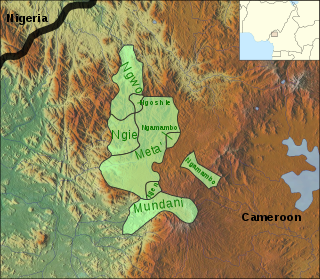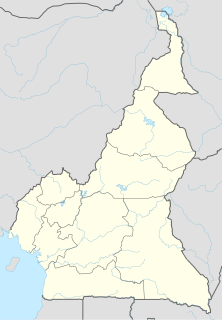Related Research Articles

Benue–Congo is a major subdivision of the Niger–Congo language family which covers most of Sub-Saharan Africa. It consists of two main branches:

Southern Bantoid is a branch of the Bantoid language family of the Benue-Congo language family. It consists of the Bantu languages along with several small branches and isolates of eastern Nigeria and west-central Cameroon. Since the Bantu languages are spoken across most of Sub-Saharan Africa, Southern Bantoid comprises 643 languages as counted by Ethnologue, though many of these are mutually intelligible.

The Tivoid languages are a subfamily of the Southern Bantoid languages spoken in parts of Nigeria and Cameroon.
The Kom are one of the principal ethnic groups of the North-West province of Cameroon, where traditional government institutions are very important. The capital, Laikom, is the seat of the ruler, the Fon, and his advisors, the Quifon, who continue to be the most respected leaders despite the imposition of a central Cameroonian government. Vincent Yuh II died in November 2017, Fon Ndzi II is the current Fon of Kom. The Cameroonian government recognizes to some degree the authority of the Fons and local chiefs subject to them.
Vengo (Vəŋo), or Babungo, is a Grassfields language and the language of the Vengo people from the village of Babungo in the Cameroonian Grassfields. The spelling Bamungo is also often found.
Bambui is an emerging township in northwestern Cameroon. With a population of about 17,000 people, it is located at an elevation of about 1350 metres above sea level. Administratively, Bambui is the headquarters of Tubah Sub-Division in the North West Region of Cameroon. Popularly known to its inhabitants as “abeh-mbeuh,” Bambui is one of the Bamenda grassfield communities of Cameroon, and is known for its mix of modern and indigenous African life. With its lush, rolling, and fertile plains, a mild tropical climate, and an extremely industrious farming community, Bambui is the bread basket of the North West Region in particular and of Cameroon in general. Lying snug in the immense arms of the Sabga hill, Bambui is situated between Sabga and the undulating foothills that separate it with its neighbors, virtually in the shape of a bowl. Bambui is located at the cross-roads that lead to some of the North West Region's major towns of Bamenda, Ndop, Kumbo, Fundong and Nkambé.
The Bamileke languages are a group of Eastern Grassfields languages spoken by the Bamileke people in the Western High Plateau of Cameroon.
The Kom language, Itaŋikom, is the language spoken by the Kom people of Cameroon. Shultz 1997a and Shultz 1997b contain a comprehensive description of the language's grammar.
The Bafut Subdivision or the Kingdom/Chiefdom/Fondom of Bafut is a commune in the Mezam Department of Northwest Province, Cameroon. It is located in the Western Grassfields region - a name for the Northwest Province and surrounding grassland areas. Bafut is the most powerful of the traditional kingdoms of the Grassfields, now divided into 26 wards along a 10 kilometre stretch of the "Ring Road" that trails along a ridge above the Menchum Valley.

The Grassfields languages are a branch of Benue–Congo spoken in the Western High Plateau of Cameroon and a sister group to the Bantu languages. Better known Grassfields languages include the Eastern Grassfields languages Bamun, Yamba and Bamileke and the Ring language Kom. The languages are closely related, sharing approximately half of their vocabulary.

Nkambe is a city in the Northwest Region of Cameroon. It is the headquarters of the Donga-Mantung department. Nkambe Central is also the name of one of the five communes in Donga-Mantung. Nkambe lies at the north edge of the Bamenda Grassfields, on the northeast arc of the Ring Road, farthest from Bamenda. The Nigerian border is only 25 or 40 km away, but roads toward the border are undeveloped jungle tracks.
The Eastern Grassfields languages, spoken in the Western High Plateau of Cameroon, are a branch of the Grassfields languages including Bamun, Yamba and Bamileke.

The Ngemba languages are a group of Eastern Grassfields languages of the Western High Plateau of Cameroon.

The Momo languages are a branch of the Southern Bantoid languages spoken in the Western grassfields of Cameroon.

Misaje is a town and commune in Donga-Mantung department in the Northwest Region of Cameroon. The town lies at the top of the Ring Road, about 15 kilometers west of Nkambé, where the Ring Road meets the road north to Dumbu and the border with Nigeria.
Limbum is a Grassfields language of Cameroon, with a small number of speakers in Nigeria. It is used as a trade language by some, but is primarily the mother tongue of the Wimbum people, who live in Donga-Mantung division of the Northwest Region, at the top of the Ring Road.
Mmem (Bafmeng) is a Grassfields Bantu language of Cameroon.
Bum is a Grassfields Bantu language of Cameroon.
The Baba language, Supapya’, is a Grassfields language of Cameroon.
The Menyam language, Bamenyam, is a Grassfields language of Cameroon.
References
- ↑ Hammarström, Harald; Forkel, Robert; Haspelmath, Martin, eds. (2017). "Ring". Glottolog 3.0 . Jena, Germany: Max Planck Institute for the Science of Human History.